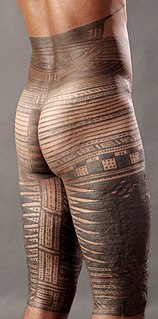
The Polynesian narrative or Polynesian mythology encompasses the oral traditions of the people of Polynesia, a grouping of Central and South Pacific Ocean island archipelagos in the Polynesian Triangle together with the scattered cultures known as the Polynesian outliers. Polynesians speak languages that descend from a language reconstructed as Proto-Polynesian that was probably spoken in the Tonga - Samoa area around 1000 BC.
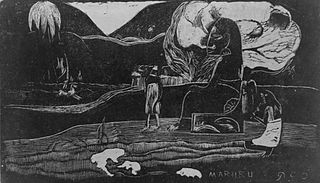
Hina is the name assigned to a number of Polynesian deities. The name Hina usually relates to a powerful female force who has dominion over a specific entity. Some variations of the name Hina include Sina, Hanaiakamalama, and Ina. Even within a single culture, Hina could refer to multiple goddesses and the distinction between the different identities are not always clear. In Hawaiian mythology, the name is usually paired with words which explain or identify the goddess and her power such as Hina-puku-iʻa (Hina-gathering-seafood) the goddess of fishermen, and Hina-ʻopu-hala-koʻa who gave birth to all reef life.

In Māori mythology, Tangaroa is one of the great gods, the god of the sea. He is a son of Ranginui and Papatūānuku, Sky and Earth. After he joins his brothers Rongo, Tūmatauenga, Haumia, and Tāne in the forcible separation of their parents, he is attacked by his brother Tāwhirimātea, the god of storms, and forced to hide in the sea. Tangaroa is the father of many sea creatures. Tangaroa's son, Punga, has two children, Ikatere, the ancestor of fish, and Tū-te-wehiwehi, the ancestor of reptiles. Terrified by Tāwhirimātea's onslaught, the fish seek shelter in the sea, and the reptiles in the forests. Ever since, Tangaroa has held a grudge with Tāne, the god of forests, because he offers refuge to his runaway children.
Atua are the gods and spirits of the Polynesian peoples such as the Māori or the Hawaiians. The Polynesian word literally means power or strength and so the concept is similar to that of mana. Today, it is also used for the monotheistic conception of God. Especially powerful atua included:
In the mythology of Tonga, Havea Hikuleʻo is the god of the world, Pulotu. The islands of Kao, Tofua, Hunga Haʻapai, Hunga Tonga, Late and Fonualei came from stones thrown down from the skies by Hikuleʻo. They are all volcanic islands. The other, (coral) islands were fished up by his brother or cousin Maui.

Aunu'u is a small volcanic island off the southeastern shore of Tutuila in American Samoa. It has a land area of 374.83 acres and a 2000 census population of 476 persons. Politically it is a part of the Eastern District, one of the primary divisions of American Samoa. The island is located in Sa'Ole County.

In Hawaiian religion, Māui is a culture hero and ancient chief who appears in several different genealogies. In the Kumulipo, he is the son of ʻAkalana and his wife Hina-a-ke-ahi (Hina). This couple has four sons, Māui-mua, Māui-waena, Māui-kiʻikiʻi, and Māui-a-kalana. Māui-a-kalana's wife is named Hinakealohaila, and his son is named Nanamaoa. Māui is one of the Kupua. His name is the same as that of the Hawaiian island Maui, although native tradition holds that it is not named for him directly, but instead named after the son of Hawaii's discoverer.
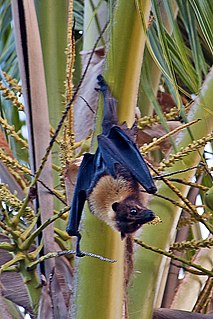
The Samoa flying fox or Samoan flying fox is a species of flying fox in the family Pteropodidae. It is found in American Samoa, Fiji, and Samoa. Its natural habitat is subtropical or tropical dry forests. It is threatened by habitat loss.

Sina and the Eel is a myth of origins in Samoan mythology, which explains the origins of the first coconut tree.
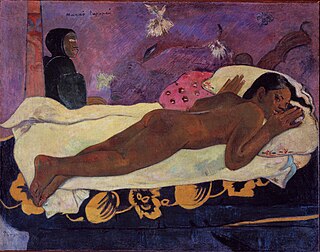
There was widespread belief in ghosts in Polynesian culture, some of which persists today. After death, a person's ghost would normally travel to the sky world or the underworld, but some could stay on earth. In many Polynesian legends, ghosts were often involved in the affairs of the living. Ghosts might also cause sickness or even invade the body of ordinary people, to be driven out through strong medicines.
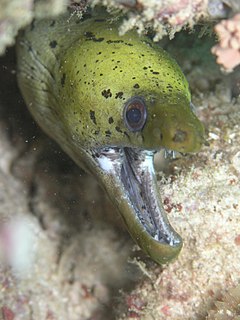
Tuvaluan mythology tells stories of the creation of the islands of Tuvalu and of the founding ancestors of each island. While on some of the islands there are stories of spirits creating the islands, a creation story that is found on many of the islands is that te Pusi mo te Ali created the islands of Tuvalu; te Ali is believed to be the origin of the flat atolls of Tuvalu and the te Pusi is the model for the coconut palms that are important in the lives of Tuvaluans. The strength of this belief has the consequence that Moray eel is tapu and is not eaten.

